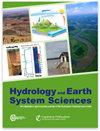景观结构调整了降雨量衰退的对比反应
IF 5.8
1区 地球科学
Q1 GEOSCIENCES, MULTIDISCIPLINARY
引用次数: 0
摘要
摘要。由水文过程、径流动力学和集水区蓄水量形成的径流衰退在很大程度上受景观结构和暴雨特征的影响。然而,我们对衰退与景观结构和暴雨特征之间的关系的理解仍然不一致,研究它们的综合影响的研究有限。本研究考察了通过去相关过程获得的291组衰退参数在形成衰退反应中的相互作用。这些数据来自19条亚热带山地河流,涵盖了降雨量范围很广的事件。主要研究结果表明,随着L/G比(流道长度与坡度之比的中位数)的增加,退缩系数(a)增加,指数(b)减少,这表明较长、较平缓的山坡有利于水流积累和含水层连通性,最终降低了非线性。此外,在大流域,由于景观异质性较大,指数(b)随着降雨量的增加而增加。相反,在小流域,它随着降雨而下降,表明这些流域的景观异质性较小,从而减少了径流的异质性。我们的研究结果强调了进一步验证L/G和流域面积如何调节不同地区不同降雨量的衰退响应的必要性。本文章由计算机程序翻译,如有差异,请以英文原文为准。
Landscape structures regulate the contrasting response of recession along rainfall amounts
Abstract. Streamflow recession, shaped by hydrological processes, runoff dynamics, and catchment storage, is heavily influenced by landscape structure and rainstorm characteristics. However, our understanding of how recession relates to landscape structure and rainstorm characteristics remains inconsistent, with limited research examining their combined impact. This study examines this interplay in shaping recession responses upon 291 sets of recession parameters obtained through the decorrelation process. The data originate from 19 subtropical mountainous rivers and cover events with a wide spectrum of rainfall amounts. Key findings indicate that the recession coefficient (a) increases while the exponent (b) decreases with the L/G ratio (the median of ratios between flow-path length and gradient), suggesting that longer and gentler hillslopes facilitate flow accumulation and aquifer connectivity, ultimately reducing nonlinearity. Additionally, in large catchments, the exponent (b) increases with increasing rainfall due to greater landscape heterogeneity. Conversely, in small catchments, it declines with rainfall, indicating that these catchments have less landscape heterogeneity and thus reduced runoff heterogeneity. Our findings underscore the necessity for further validation of how L/G and drainage area regulate recession responses to varying rainfall levels across diverse regions.
求助全文
通过发布文献求助,成功后即可免费获取论文全文。
去求助
来源期刊

Hydrology and Earth System Sciences
地学-地球科学综合
CiteScore
10.10
自引率
7.90%
发文量
273
审稿时长
15 months
期刊介绍:
Hydrology and Earth System Sciences (HESS) is a not-for-profit international two-stage open-access journal for the publication of original research in hydrology. HESS encourages and supports fundamental and applied research that advances the understanding of hydrological systems, their role in providing water for ecosystems and society, and the role of the water cycle in the functioning of the Earth system. A multi-disciplinary approach is encouraged that broadens the hydrological perspective and the advancement of hydrological science through integration with other cognate sciences and cross-fertilization across disciplinary boundaries.
 求助内容:
求助内容: 应助结果提醒方式:
应助结果提醒方式:


